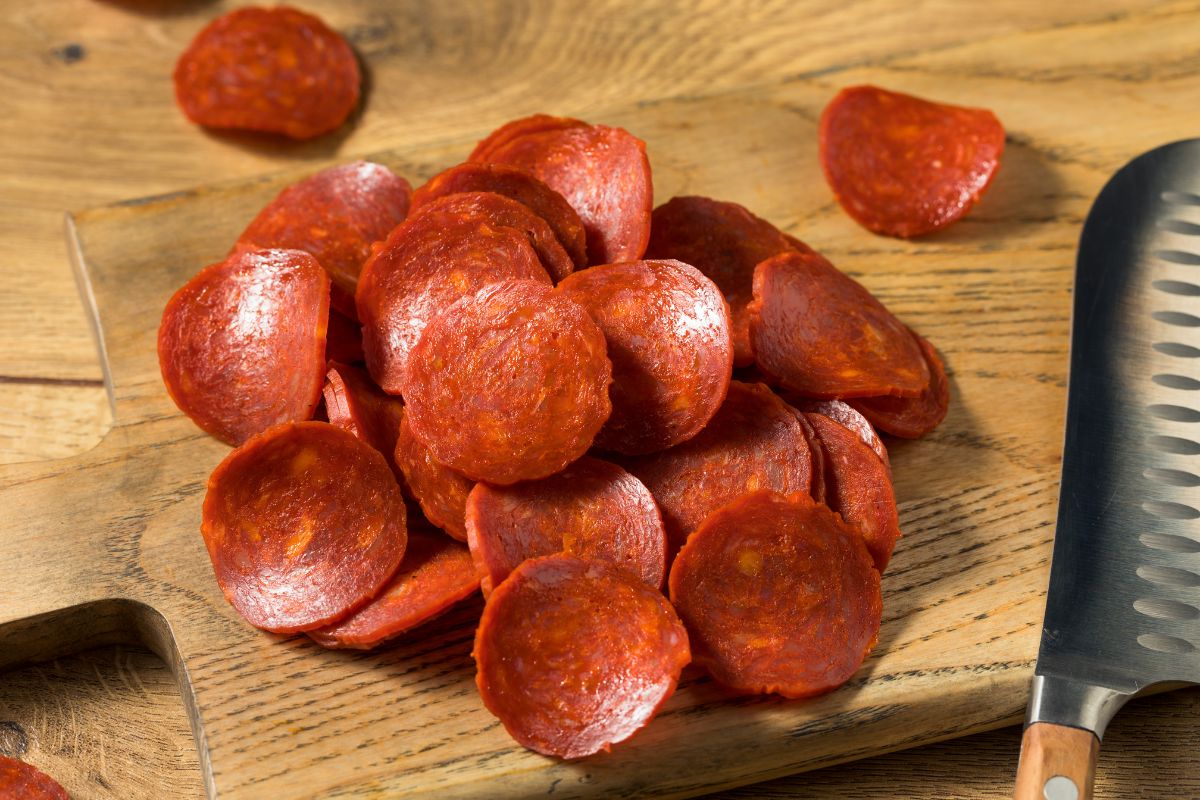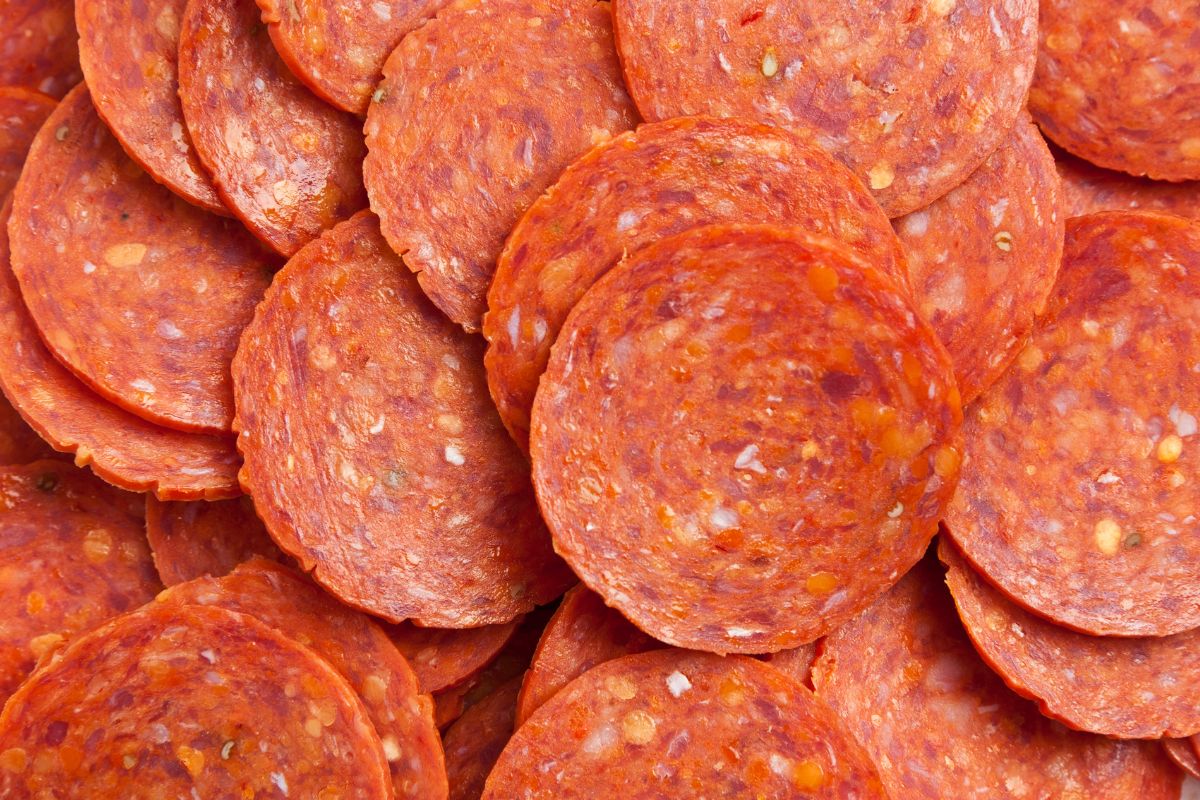As America’s favorite pizza topping, pepperoni comes with a complex flavor profile. While you may believe it to be as Italian as salami, it is an American creation and was first reported to be put on pizzas in Lower Manhattan.
There are several spices that go into every pepperoni sausage as well as ground meat which forms its main component.

It can take time to create so you may be wanting to know what pepperoni is made of.
In this guide, we will detail what pepperoni is made of. We will specifically look at the ingredients of pepperoni, how pepperoni is made, as well as the history behind this spiced sausage when it is used as a pizza topping.
What Is Pepperoni Made Of?
Pepperoni is known as a spicy cured meat that is primarily made from ground pork meat though the pork can be combined with beef. It has a distinctive soft texture and a smoky, spicy flavor which works well when eaten raw and even better when cooked.
Ground meat is the main component of each pepperoni sausage and it is bound together after being mixed with several spices.
The Ingredients Of Pepperoni
As well as ground meat, likely pork, you can expect plenty of spices to be involved in pepperoni too. What gives each pepperoni sausage its vivid red color and smoky aroma is a healthy serving of paprika.
You can expect to find black peppercorns through the sausage for a heady kick and a pungent flavor.
Some ground garlic cloves or powdered garlic also add a tang that works well with the smokiness of the other spices.
For a sweetness to pepperoni, you can expect to find a few pinches of mixed herbs, specifically including mustard and fennel seeds.
Another pepper aspect involved in pepperoni is crushed red pepper flakes which can be added whole or in a coarsely ground form for color and an extra spicy taste.
You can expect even more color and flavor when cayenne pepper is added to the mix too.
How Pepperoni Is Made
The meat in each pepperoni sausage is typically ground pork. This is then mixed up with several flavorings and spices to help create that distinctly bold flavor and color.
To cure the meat, sodium nitrate and salt are added and this also helps to prevent unwanted microorganisms from growing and spoiling the meat.
While you may think that the red color comes from paprika or crushed red pepper flakes, pepperoni actually gains its color once that nitrate is added.
To reduce the meat’s pH balance, lactic acid bacteria is injected straight into the meat. This helps the sausage’s preservation so it is easier to consume once it has been cured.
The mixture of ground pork and spices is forced into casings with ferments for a few days. Each pepperoni sausage is then left in a drying room to cure for a maximum of 20 days, just like other sausages and salamis.
Finally, the pepperoni sausages will have dried out. At this point, the sausages can be packaged appropriately and then shipped out to various delicatessens. It can be served whole to be sliced at the table or arrive pre-sliced.
The History Of Pepperoni On Pizza
While pizza comes from Italy, the thought of adding sliced pepperoni to a pizza actually comes from America. That’s largely why a lot of Italians fail to fully accept pepperoni as a pizza topping as it fails to be as authentic as a Neapolitan pizza.
The word, ‘pepperoni’ derives from the Italian word, ‘peperoni’, which is the plural of ‘peperone’ which is a large bell pepper.
This may all seem a little strange once you realize that curing meats is an Italian tradition. Even if pepperoni may not seem truly Italian, and certainly adding slices of it to a pizza is not, curing meat began with the Ancient Romans.

That can create a contradiction, while pepperoni is frowned upon as a pizza topping in Italy, curing meats is definitely an Italian tradition.
However, pepperoni is a decidedly American invention as there is no Italian salami that goes by that name, though there are similar ones in color and flavor to be found in Milan.
Pepperoni as a pizza topping was first noted in New York City back in 1919 when the word first appeared in print. This is roughly the same time that Italian butcher shops and pizzerias popped up in New York City and along the East Coast.
You can call pepperoni an Italo-American invention as it was developed in American-based, Italian-run pizzerias. These were specifically the pizzerias of Lower Manhattan.
Final Thoughts
Some people cannot imagine enjoying a pizza without pepperoni as a topping. It is dotted with fat throughout and each sausage may have as much as 30-35% of fat.
Even then, only choice cuts of pork are used along with very specific spices , color enhancers, and starter cultures. It can take days to create a pepperoni sausage and it should have a consistent diameter so each slice is the same uniform size.
Frequently Asked Questions
Pepperoni was first made from ground pork though it can be a mixture of ground pork and beef. If only ground pork is used, it will be from the belly and shoulder which has a higher fat content than other cuts.
It’s the fat, as well as the spices, that can give pepperoni a great taste that works really well as a pizza topping. Recently, you can expect more pepperoni sausages to be made with different meat including turkey.
Part of the appeal of pepperoni as a pizza topping is how each slice softens up when baked on top of a pizza. The fat dissolves and produces such a flavor profile including smoky, salty, sour, and spicy notes.
With so many different aspects to its flavor, you should leave it on its own so as not to lose any of that potency. The pizza sauce should also be packed full of flavor with oregano, basil, garlic, and onion powder with tomato paste, sugar, and salt.
- How To Reheat A Cheesesteak - November 5, 2023
- What Are Three Must Have Kitchen Knives? - September 22, 2023
- How To Protect Edges Of Pie Crust - June 15, 2023








